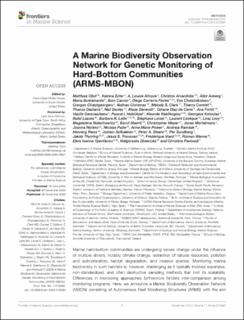A Marine Biodiversity Observation Network for Genetic Monitoring of Hard-Bottom Communities(ARMS-MBON)
Obst, Matthias; Exter, Katrina; Allcock, A. Louise; Arvanitidis, Christos; Axber, Alizz; Bustamante, Maria; Cancio, Ibon; Carreira-Flores, Diego; Chatzinikolaou, Eva; Chatzigeorgiou, Giorgos; Chrismas, Nathan; Clark, Melody S.; Comtet, Thierry; Dailianis, Thanos; Davies, Neil; Deneudt, Klaas; de Cerio, Oihane Diaz; Fortic, Ana; Gerovasileiou, Vasilis; Hablützel, Pascal I.; Keklikoglou, Kleoniki; Kotoulas, Georgios; Lasota, Rafal; Leite, Barbara R.; Loisel, Stéphane; Lévêque, Laurent; Levy, Liraz; Malachowicz, Magdalena; Mavric, Borut; Meyer, Christopher; Mortelmans, Jonas; Norkko, Joanna; Pade, Nicolas; Power, Anne Marie; Ramšak, Andreja; Reiss, Henning; Solbakken, Jostein; Staehr, Peter A.; Sundberg, Per; Thyrring, Jakob; Troncoso, Jesus S.; Viard, Frédérique; Wenne, Roman; Yperifanou, Eleni Ioanna; Zbawicka, Malgorzata; Pavloudi, Christina
Peer reviewed, Journal article
Published version

View/
Date
2020Metadata
Show full item recordCollections
Original version
Obst, M., Exter, K., Allcock, A. L., Arvanitidis, C., Axber, A., Bustamante, M. ... Pavloudi, C. (2020). A Marine Biodiversity Observation Network for Genetic Monitoring of Hard-Bottom Communities(ARMS-MBON). Frontiers in Marine Science, 7: 572680. doi: 10.3389/fmars.2020.572680Abstract
Marine hard-bottom communities are undergoing severe change under the influence of multiple drivers, notably climate change, extraction of natural resources, pollution and eutrophication, habitat degradation, and invasive species. Monitoring marine biodiversity in such habitats is, however, challenging as it typically involves expensive, non-standardized, and often destructive sampling methods that limit its scalability. Differences in monitoring approaches furthermore hinders inter-comparison among monitoring programs. Here, we announce a Marine Biodiversity Observation Network (MBON) consisting of Autonomous Reef Monitoring Structures (ARMS) with the aim to assess the status and changes in benthic fauna with genomic-based methods, notably DNA metabarcoding, in combination with image-based identifications. This article presents the results of a 30-month pilot phase in which we established an operational and geographically expansive ARMS-MBON. The network currently consists of 20 observatories distributed across European coastal waters and the polar regions, in which 134 ARMS have been deployed to date. Sampling takes place annually, either as short-term deployments during the summer or as long-term deployments starting in spring. The pilot phase was used to establish a common set of standards for field sampling, genetic analysis, data management, and legal compliance, which are presented here. We also tested the potential of ARMS for combining genetic and image-based identification methods in comparative studies of benthic diversity, as well as for detecting non-indigenous species. Results show that ARMS are suitable for monitoring hard-bottom environments as they provide genetic data that can be continuously enriched, re-analyzed, and integrated with conventional data to document benthic community composition and detect non-indigenous species. Finally, we provide guidelines to expand the network and present a sustainability plan as part of the European Marine Biological Resource Centre (www.embrc.eu).
